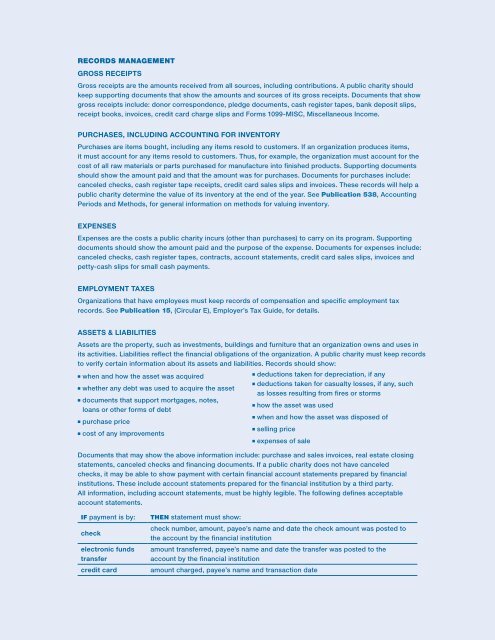The EDTC Incubator
The EDTC Incubator
The EDTC Incubator
Create successful ePaper yourself
Turn your PDF publications into a flip-book with our unique Google optimized e-Paper software.
RECORDS MANAGEMENT<br />
GROSS RECEIPTS,<br />
Gross receipts are the amounts received from all sources, including contributions. A public charity should<br />
keep supporting documents that show the amounts and sources of its gross receipts. Documents that show<br />
gross receipts include: donor correspondence, pledge documents, cash register tapes, bank deposit slips,<br />
receipt books, invoices, credit card charge slips and Forms 1099-MISC, Miscellaneous Income.<br />
PURCHASES, INCLUDING ACCOUNTING FOR INVENTORY,<br />
Purchases are items bought, including any items resold to customers. If an organization produces items,<br />
it must account for any items resold to customers. Thus, for example, the organization must account for the<br />
cost of all raw materials or parts purchased for manufacture into finished products. Supporting documents<br />
should show the amount paid and that the amount was for purchases. Documents for purchases include:<br />
canceled checks, cash register tape receipts, credit card sales slips and invoices. <strong>The</strong>se records will help a<br />
public charity determine the value of its inventory at the end of the year. See Publication 538, Accounting<br />
Periods and Methods, for general information on methods for valuing inventory.<br />
EXPENSES<br />
Expenses are the costs a public charity incurs (other than purchases) to carry on its program. Supporting<br />
documents should show the amount paid and the purpose of the expense. Documents for expenses include:<br />
canceled checks, cash register tapes, contracts, account statements, credit card sales slips, invoices and<br />
petty-cash slips for small cash payments.<br />
EMPLOYMENT TAXES<br />
Organizations that have employees must keep records of compensation and specific employment tax<br />
records. See Publication 15, (Circular E), Employer’s Tax Guide, for details.<br />
17<br />
ASSETS & LIABILITIES<br />
Assets are the property, such as investments, buildings and furniture that an organization owns and uses in<br />
its activities. Liabilities reflect the financial obligations of the organization. A public charity must keep records<br />
to verify certain information about its assets and liabilities. Records should show:<br />
■ when and how the asset was acquired,<br />
■ whether any debt was used to acquire the asset, ,<br />
■ documents that support mortgages, notes,<br />
loans or other forms of debt,<br />
■ purchase price, ,<br />
■ cost of any improvements,,<br />
■ deductions taken for depreciation, if any ,,<br />
■ deductions taken for casualty losses, if any, such<br />
as losses resulting from fires or storms,<br />
■ how the asset was used,<br />
■ when and how the asset was disposed of,<br />
■ selling price,<br />
■ expenses of sale,<br />
Documents that may show the above information include: purchase and sales invoices, real estate closing<br />
statements, canceled checks and financing documents. If a public charity does not have canceled<br />
checks, it may be able to show payment with certain financial account statements prepared by financial<br />
institutions. <strong>The</strong>se include account statements prepared for the financial institution by a third party.<br />
All information, including account statements, must be highly legible. <strong>The</strong> following defines acceptable<br />
account statements.<br />
IF payment is by:<br />
check<br />
electronic funds<br />
transfer<br />
credit card<br />
THEN statement must show:<br />
check number, amount, payee’s name and date the check amount was posted to<br />
the account by the financial institution<br />
amount transferred, payee’s name and date the transfer was posted to the<br />
account by the financial institution<br />
amount charged, payee’s name and transaction date

















